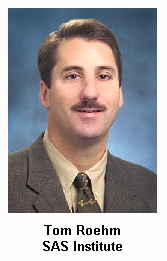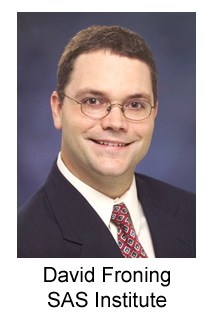Warranty Analysis:
Rather than becoming another "accidental" warranty software vendor, SAS Institute was driven into the market by customers such as GM and Ford.
Numerous Warranty Week articles have documented the fact that few if any of the software developers now selling warranty software actually set out to overtly become warranty software developers. Usually, they happened upon warranty by accident, while they were chasing a supposedly more lucrative market such as customer relationship management or business intelligence software. But when a potential customer says they're in the market for some new warranty software, these developers quickly change their tune.
Also common is a phenomenon whereby companies develop an analysis capability or database technology that becomes a solution in search of a problem. And guess which problem they encounter first? It's warranty, that overlooked and underserved $40 billion industry that's so neglected it doesn't even have its own acronym. But where would the whole text mining sector be without warranty? What capability would the Early Warning System vendors be selling were it not for warranty data?
Sometimes it's not the tools vendor that finds warranty at all. Sometimes it's the customer who has the problem, and it's the customer that sees the value of the technology. In the case of SAS Institute Inc., at least initially it was the customer who actually built the warranty software application using the basic tools. Later on, some of the very people who built their own homegrown warranty software applications went to work for SAS, where they turned these tools and capabilities into a commercial warranty software offering.
A Brief History of SAS
SAS Institute was co-founded in 1976 by Jim Goodnight, John Sall, and two other partners. At the time, Goodnight was a graduate student and faculty member at North Carolina State University in Raleigh, and his family owned a significant plot of land south of the city. While in school, he had written a mainframe-based statistical analysis package that was proving to be quite popular even outside its intended agricultural applications.
By 1978 the company had 600 customers. By 1980 part of Goodnight's family farm had become the SAS campus in Cary, NC. By 1981 its software was installed at more than 3,000 sites. The company forged numerous computer industry partnerships, first with IBM, then with Hewlett-Packard, Microsoft, Apple Computer, Sun Microsystems, and Intel. Today, SAS Institute is the world's largest privately-held software company, with 40,000 customers in 110 countries, 9,640 employees, 356 offices, and $1.5 billion in revenue. It's also one of the sponsors of the Warranty Week newsletter.

Tom Roehm, the senior director of the SAS Supply Chain Group, said as far as he can tell, SAS became a commercial warranty software developer some time around 2002, with the initial release of SAS Warranty Analysis. However, customers such as Ford Motor Co. and General Motors report that they were using SAS statistical analysis tools for quality control and warranty analysis as far back as 1982.
"My guess is the people that were doing it back then were not the everyday end users," he said. "They were probably more their statisticians." SAS tools, which had come out of a university environment, appealed very strongly to the academic types, who knew how to write routines that could crunch numbers on those giant air-conditioned and water-cooled mainframes that nobody else knew how to program.
"We didn't even have a sales force back then," Roehm said. "It would primarily be these Ph.Ds, people in R&D departments, and statistician that obviously recognized the power of analytics and statistics, and started solving business problems on their own, within their own companies."
Customer-Driven Warranty Analysis
General Motors' R&D department started using SAS software tools in 1977, and began using it for warranty in 1982. Hundreds of other companies as well as many universities also began deploying the tools, in hundreds of ways and for hundreds of purposes that SAS had little control over, let alone knowledge about. It was very much a customer-driven phenomenon, which in the tightly-controlled world of the mainframe made it all the more remarkable. Basically, the SAS package was a high-end statistical analysis tool that sat on the mainframe. If you knew how to format your data and how to structure your equations properly, it could print amazing things on that green and white computer paper. If not, well, there were always Snoopy calendars that needed to be made.
It wasn't until the 1990s that the use of these sophisticated SAS tools began to grow outside the doctorial stratum. By then, SAS tools were spreading horizontally within major manufacturing companies such as Ford and GM -- moving out of the R&D departments -- and were being used as the basis of some early homegrown warranty applications. In fact, that's how Roehm was first exposed to SAS.
Roehm joined SAS at the end of 1999 after spending several years employed by Electronic Data Systems and General Motors, where he worked in the quality and service departments, particularly within the warranty space. While at EDS, Roehm helped build an application for GM called Quality With Information & Knowledge (QWIK), which was based upon SAS tools.
"This was about 1996," he said. "I didn't know much about SAS." So he looked at a variety of analysis software packages that could prove to be useful, including Cognos, MicroStrategy, and SAS. "I ended up doing a bake-off between the different software vendors," Roehm said. "And I ended up selecting SAS. So we built a client-server application. And it's still in use today."
Once he joined SAS, he landed in the manufacturing practice, then moved over to automotive, and then into supply chain. "That's when SAS began investing more in industry domains," he said. One of the first action items was to figure out how manufacturers were using SAS tools, what were their greatest pain points, and what SAS could do to package some of these uses into saleable solutions.
Packaged Warranty Solutions
"After analyzing the market space and how our customers were using SAS in manufacturing (and where pains were very high), we decided to pursue packaging a warranty solution. I was the person in SAS who drove this initiative and Dave [Froning] was our product manager who gathered requirements and eventually defined the product."

Dave Froning, who also first became involved in warranty while working at GM, followed Roehm to SAS roughly a year later, in October 2000. "While Tom [Roehm] was at EDS, I was actually his customer at General Motors," he said. "My role there was basically as business process owner for warranty analysis systems. So for several different analysis systems that were in place, I was the person going out to the business units, gathering requirements, and then working with Tom to figure out the best software for those needs."
Froning immediately jumped into warranty analysis as soon as he joined SAS. "At the time, we were still selling just tools, but we were starting the idea of building a packaged application. And I've basically been the product manager for SAS Warranty Analysis ever since."
After GM and Ford came American Honda, Renault Truck, and Mack Truck, which all began using SAS tools in their own homegrown warranty analysis applications in the mid to late 1990s. "The other change we saw in the 1990s was that it was growing beyond automotive and heavy truck," Froning said. "They were the main customers in the 80s, but then into the 90s we started seeing many more white goods and high-tech manufacturers -- companies like Maytag, Maxtor, and others who were either building warranty analysis applications on their own or using our consultants to do it. Another from that timeframe is Sears, which started using our tools to analyze warranty data."
Meanwhile, SAS was beginning to build some packaged solutions for horizontal applications such as human resources and finance. Later, the company began looking for specific vertical industries, and automotive became one of the top priorities. By 2000, Roehm and Froning were internally advocating the launch of a formal and commercial set of warranty analysis tools for automotive OEMs such as their former employer.
"There was a time in the 90s where we were selling the idea of warranty analysis using SAS tools," Froning said. "It just wasn't a packaged application. We went from customers figuring this out for themselves to us deciding this was a market we should go after."
Customer Research
But in truth, it was the customers who helped them figure out there was a market for warranty analysis software. Indeed, Froning and Roehm were in essence former customers themselves. But at the time, even they had no idea how widespread the homegrown phenomenon had become. That would require some market research to uncover. They knew from their time at GM what the tools could do when they were pointed at warranty data. But they had to prove that there were more than one or two potential customers out there. So they embarked on a series of customer visits, asking questions and soliciting advice.
"One of the things we did was ask what were some of the biggest issues for manufacturers that we could solve," Roehm said. "And it looked like warranty was the one. It was beginning to gain momentum in terms of the costs, the press, and the issues. So we went out and did an inventory, because in some cases we didn't even know who was using our software for warranty. We started interviewing them, and holding focus groups for automotive suppliers. That really formed the basis -- the best practices that we picked up, as far as how people were already using our software, and then our own industry experience -- of the specifications for creating a packaged warranty analysis application."
Roehm said right around 2001, he personally started tagging along on some sales calls, where he would pitch the use of SAS tools for warranty analysis. On one such sales call at Mack Trucks, his pitch was greeted by the news that the company already was using SAS tools for warranty analysis. "We didn't have our packaged application yet but we were starting to bundle some things at this point," Roehm said, "and we come to find out they're using SAS for warranty. In many cases, we didn't always know who was using it."
SAS Warranty Analysis Debuts
As in any business, the customer is always right, so after discovering how popular SAS analytical tools already were in the warranty sector, the company decided to develop what eventually came to be known as SAS Warranty Analysis. They chose the name in 2001 and formally put the product on the market in 2002.
One of the first customers for the packaged application was Allison Transmission, a division of General Motors. They were followed by Freightliner, Mitsubishi Motors North America, Shanghai General Motors, Sub-Zero Freezer Co., Volvo Trucks, and Whirlpool, among others. Plus there's still numerous companies that used SAS tools to build homegrown warranty applications, including those mentioned above plus Hewlett-Packard, Maytag, and Nissan. And there's a few that don't want their names mentioned, including a tire manufacturer and a motorcycle manufacturer.
Froning said the main difference between the pre-2002 tools and the post-2002 package is the inclusion of warranty-specific business rules. "So you're not just pointing a generic analysis tool at warranty data," he said, "as you would if you bought SAS or another tool off the shelf. You're getting a lot of best practices that we've learned over the years -- things like how to deal with the maturity of the data, how to work around sales lag problems, or [how to work around] incomplete sales data.
"We also include a packaged early warning component that we call 'Emerging Issues.' And that really is one of the most important and most beneficial pieces of the application for most of our customers," Froning said. "It basically finds things that are failing at a higher-than-normal rate, but on an automated basis. It goes out and identifies new issues out in the field without forcing your analysts to look through hundreds or thousands of charts. It flags them and notifies the appropriate analyst or engineer to let them know that there's a problem they need to investigate."
Multiple Analysis Tools & Techniques
Roehm noted that the software is not just looking for failure events that exceed some pre-specified rate. What it's doing is calculating a baseline -- a range of "normal" levels that help it identify an abnormal rate. And because incoming warranty data can be so disorganized and sometimes even inaccurate, it has to be able to discern the signal from the noise. "It's looking at every record that's coming in," he said. "It's looking at exposures, time in service, production date, and it's looking at the month of the claim. And it's determining whether it's within an acceptable range. If not, it sends out an alert."
Froning said that after numerous interviews with warranty experts and academics, SAS decided that when it comes to warranty data analysis, there really is no one single right way. Taking what he called a combined approach, the software brings multiple analytical techniques together into one system: control charts, reliability analysis, regression, etc. Likewise, there are multiple output formats: scorecards for executives, problem-solving tools for product engineers, and modeling tools for statisticians, etc.
These days, warranty software is a major part of the SAS product line. Within the manufacturing sector, warranty is now the top focus, Roehm said. And manufacturing customers account for roughly 10.5% of the company's total $1.5 billion revenue stream -- second in size behind the financial services sector. SAS doesn't break out revenue by solution, but it's likely that SAS Warranty Analysis is the top seller within the Supply Chain Intelligence suite.
Unlike many of the "accidental" warranty software vendors profiled in issues past, it was a lengthy 20-year process before SAS Institute discovered this new market segment. They didn't stumble upon it suddenly, like so many business intelligence and text analysis companies. And through most of those 20 years, customers were building their own warranty software without SAS knowing much about it. In fact, it was not only customers who suggested it, but also customers-turned-employees who packaged and marketed the software.
 |








